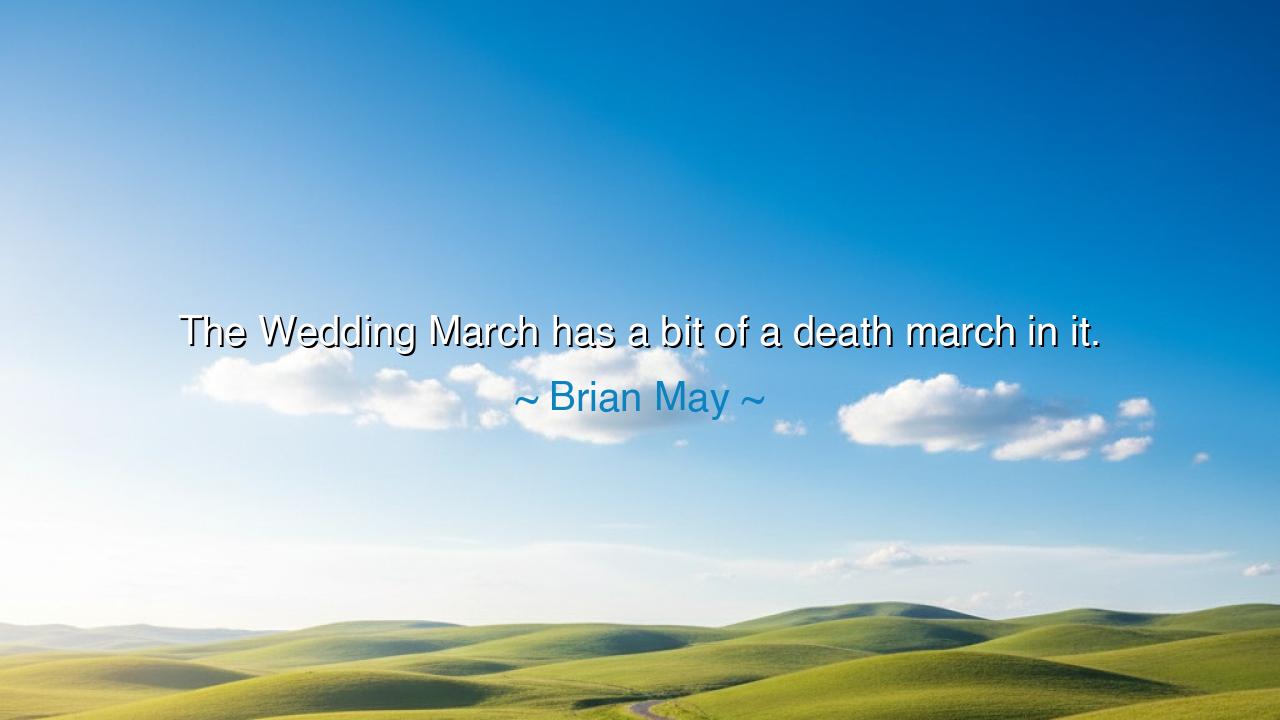
The Wedding March has a bit of a death march in it.






The musician and philosopher of sound, Brian May, once spoke with wry wisdom when he said: “The Wedding March has a bit of a death march in it.” At first, the words may seem humorous — a clever jest about marriage — yet beneath their surface lies an ancient and profound truth about the duality of union and loss, of love and transformation. In the rhythm of his observation beats the eternal paradox of human life: that every beginning carries within it the echo of an ending, and every joy conceals a shadow of change. Like the solemn undercurrent in a joyous melody, May reminds us that life’s celebrations are never free from the pulse of mortality.
From the earliest times, music has carried the language of the soul, saying with sound what words could never fully speak. The Wedding March, written by Mendelssohn, was meant to proclaim triumph and happiness — two souls joined, two destinies intertwined. Yet even in its grandeur, one can hear the measured, deliberate rhythm that resembles the tread of a march — a rhythm that speaks not only of ceremony, but of surrender. For in marriage, as in all great commitments, something must die for something greater to be born. The solitary “I” gives way to the shared “we.” Independence dissolves into devotion. The old self, once free and unbound, must lay itself down in sacrifice for love’s creation. Thus, in the triumphant march, there whispers the quiet song of death and rebirth.
In these words, Brian May, ever the thoughtful artist, reveals a truth known to the poets and mystics of every age: that every step toward unity carries the risk of loss. Just as day fades into night and spring gives way to autumn, so too does joy contain within it the seed of sorrow. Yet this is not a cause for despair — it is the rhythm of existence itself. The ancients called it the law of balance, the harmony that binds all opposites. To love deeply is to open oneself to pain; to bind one’s life to another is to acknowledge that both hearts will someday part, if not in anger, then in death. The death march hidden in the wedding march is the truth that makes love sacred — for it reminds us that what we cherish is fleeting, and therefore precious.
Consider the ancient tale of Orpheus and Eurydice, lovers whose story has echoed through centuries. When Eurydice died, Orpheus descended into the underworld, his music so filled with love that even the stones wept. He was granted her return, but only if he did not look back. Yet his longing overcame him, and he turned — losing her forever. Their tragedy is not one of failure, but of truth: that love, like music, is bound by the laws of time and mortality. Even as Orpheus played his final notes, the melody of reunion carried the rhythm of parting. And so it is in life — the wedding march and the death march are never far apart, for they share the same melody of devotion and impermanence.
The origin of May’s quote lies not only in wit, but in experience. As a member of Queen, he lived the extremes of creation and loss — fame, music, friendship, and grief. The death of his bandmate, Freddie Mercury, left an indelible mark on his soul. He came to understand that every joy has a shadow, and every song, no matter how triumphant, carries an undertone of mortality. The music that celebrates life also mourns its brevity. When he said the Wedding March contains a death march, he was not mocking love, but honoring its gravity. He was acknowledging that the beauty of commitment lies in its fragility — that to stand before another and vow forever is an act of defiance against time itself.
In this way, the quote becomes a meditation not only on marriage, but on all human connection. Every relationship, every dream, every triumph, carries within it the quiet awareness that it will one day end. Yet this knowledge should not darken the heart — it should awaken it. To walk to the sound of the Wedding March is to celebrate not the illusion of permanence, but the courage to love despite impermanence. The death march within it is not doom, but dignity — the acknowledgment that love is beautiful precisely because it exists under the shadow of loss.
The lesson, then, is this: embrace the duality of life. Do not seek joy without accepting sorrow, or love without acknowledging loss. Understand that endings are not the enemy of beginnings — they give them meaning. When you celebrate, do so with gratitude, knowing that every dance, every vow, every kiss, is part of life’s fleeting music. Let this awareness not fill you with fear, but with presence — for the melody is sweetest when we know it will not play forever.
Thus, Brian May’s words, simple yet profound, echo across time like the notes of a timeless hymn: “The Wedding March has a bit of a death march in it.” It is a reminder that the same rhythm that leads us into love will one day lead us into farewell. Yet this is not tragedy — it is the music of existence itself. To live is to march — not toward despair, but toward depth. And when we understand that love and loss share the same tune, we learn to dance with life as it truly is — full of joy, sorrow, and the eternal harmony between the two.






AAdministratorAdministrator
Welcome, honored guests. Please leave a comment, we will respond soon